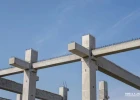The importance of roofing systems in pre-engineered steel buildings
Roofing systems play a vital role in the overall performance, durability, and functionality of pre-engineered steel buildings. As an essential component, the roofing system provides protection against weather elements, contributes to energy efficiency, ensures structural integrity, and enhances the aesthetic appeal of pre-engineered steel buildings. This article shall discuss the importance of roofing systems in pre-engineered steel buildings and factors to consider when selecting and maintaining them.
1. A brief introduction to pre-engineered steel buildings
Pre-engineered steel buildings refer to structures that are designed, fabricated, and assembled using standardized components and methods before being transported to the construction site. These buildings are engineered to meet specific requirements and are manufactured off-site, allowing for faster and more efficient construction processes.
The components of pre-engineered steel buildings, such as columns, beams, and panels, are fabricated in a factory and then assembled on-site. This construction method provides numerous advantages, including cost-effectiveness, customization options, durability, and compliance with building codes and regulations. Pre-engineered steel buildings have gained popularity in various industries, including the food industry to meet the unique needs of different applications.
2. The importance of roofing systems in pre-engineered steel buildings
2.1 Weather protection
One of the primary functions of a roofing system in pre-engineered steel buildings is to shield the building from weather elements such as rain, snow, wind, and UV radiation. A well-designed and properly installed roof effectively prevents water infiltration, protects against leaks, and keeps the interior of the building dry and safe. It also helps to regulate temperature and minimize moisture buildup, reducing the risk of structural damage, corrosion, and mold growth.

2.2 Structural integrity and load-bearing
Roofing systems in pre-engineered steel buildings contribute significantly to the structural integrity of the building. They are designed to withstand various loads, including dead loads (weight of the roof itself), live loads (such as snow or wind), and any additional equipment or machinery placed on the roof. The roofing system, along with the supporting structure, ensures that the building can withstand these loads without compromising its stability and safety.
2.3 Energy efficiency
An energy-efficient roofing system is crucial in pre-engineered steel buildings to minimize heat gain or loss and reduce energy consumption. Insulation materials and techniques incorporated into the roof assembly help to regulate internal temperatures, enhance thermal performance, and decrease the load on heating, ventilation, and air conditioning systems. This leads to energy savings, improved occupant comfort, and reduced environmental impact.

2.4 Aesthetic appeal and branding
The roofing system significantly contributes to the visual appeal and branding of pre-engineered steel buildings. It is often the most visible part of a building and can be customized to match the architectural style, purpose, and branding of the business or organization. Aesthetically pleasing roof profiles, colors, and finishes enhance the overall appearance of the building, leaving a positive impression on visitors, customers, and stakeholders.

2.5 Long-term durability and maintenance
A robust roofing system ensures the long-term durability and longevity of pre-engineered steel buildings. Steel roofing panels are known for their durability, resistance to corrosion, and low maintenance requirements. Steel roofing panels are relatively easy to maintain, requiring minimal attention and upkeep. Routine inspections to identify any signs of damage or wear, as well as regular cleaning to remove debris or dirt, are typically sufficient to keep the roofing system in optimal condition.
3. Factors to consider when installing roofing systems in pre-engineered steel buildings
When selecting and installing roofing systems for pre-engineered steel buildings, several factors should be considered to ensure optimal performance, longevity, and cost-effectiveness. Here are some key factors to keep in mind:
- Climate and weather conditions: The climate and weather conditions of the building's location are crucial considerations when selecting a roofing system. Different regions experience varying levels of rainfall, snowfall, wind speeds, and temperature fluctuations. Choose roofing materials and designs that are suitable for the local climate and can withstand the specific weather conditions prevalent in the area.
- Roofing material: Selecting the right roofing material is essential for the durability and performance of the roofing system. Consider factors such as durability, resistance to weathering, energy efficiency, maintenance requirements, and compatibility with the building's design and purpose when choosing the roofing material.
- Structural considerations: The structural capacity of the building must be taken into account when selecting a roofing system. Ensure that the roof design and materials can support the anticipated loads and any future expansion plans. Consult with structural engineers to determine the appropriate roofing system that aligns with the building's structural requirements.

Additional parts in roofing system - Installation and maintenance costs: Consider the initial installation costs as well as the long-term maintenance expenses associated with the roofing system. Some materials may have higher upfront costs but require minimal maintenance, while others may be more affordable initially but have higher maintenance and replacement costs over time. Assess the overall lifecycle costs of the roofing system to make an informed decision.
- Energy efficiency: Energy efficiency is increasingly important in modern construction. Consider roofing materials and designs that offer good insulation properties and reflectivity. An energy-efficient roofing system can help reduce heating and cooling costs and contribute to sustainability goals.
- Warranty and manufacturer's reputation: Evaluate the warranty provided by the roofing manufacturer, including coverage for defects, weather damage, and durability.
- Building codes and regulations: Ensure that the chosen roofing system complies with local building codes, regulations, and industry standards. Compliance with these standards is crucial for the safety, legality, insurance coverage, and potential future resale value of the pre-engineered steel buildings.

Above is some information regarding the importance of roofing systems in pre-engineered steel buildings. Hopefully, this article has provided you with helpful information. Visit BMB Steel’s website to read more about pre-engineered steel buildings and steel structures. You can also contact us for design consulting and steel production services.

























